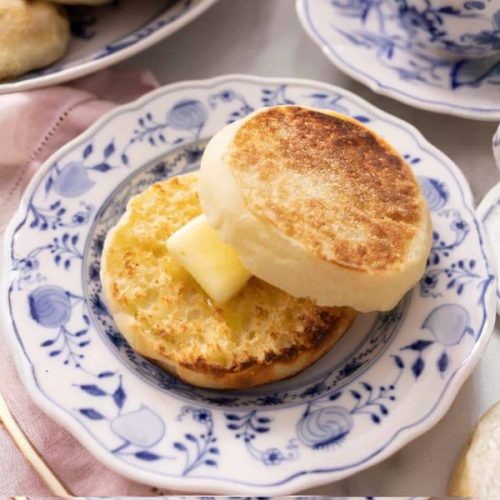
Fluffy English Muffins
Soft, lightly chewy English muffins with perfect nooks and crannies, ideal for breakfast sandwiches or toasting with butter and jam. Quick to make and naturally flavorful.
Equipment
- 1 Stand mixer with paddle attachment
- 1 3-inch round cutter
- 2 Baking sheets lined with parchment paper
- 1 Measuring cup and spoons set
Ingredients
- 2 3/4 cups 330 g all-purpose flour
- 2 1/4 tsp instant yeast 1 package
- 1 tsp salt
- 2 tbsp sugar
- 3/4 cup 180 ml milk
- 1/2 cup 120 ml water
- 3 tbsp 42 g butter, melted
- 1 large egg room temperature
- Cornmeal or semolina for dusting
Instructions
- Activate the Yeast: In a medium-sized bowl or glass measuring cup, combine the milk, water, and sugar, then gently warm the mixture to around 110°F (43°C) in the microwave or on the stovetop until it is pleasantly warm but not hot. Sprinkle in the instant yeast and stir once to incorporate, then let it rest for 5–7 minutes until the mixture becomes foamy and aromatic, signaling that the yeast is active and ready for the dough.
- Prepare the Dry Ingredients: While the yeast is activating, measure out the flour and salt into the bowl of a stand mixer fitted with a paddle attachment, then whisk them together to ensure even distribution. This step ensures that the salt and flour are well combined, which promotes uniform dough texture and prevents pockets of dry ingredients in the muffins.
- Combine Wet Ingredients: In a separate small bowl, whisk together the egg and melted butter until smooth, then gradually add this mixture to the foamy milk and yeast blend. Slowly pour the liquid into the flour mixture while the stand mixer runs on low speed, allowing the ingredients to come together gradually and form a cohesive dough.
- Knead the Dough: Increase the mixer speed to medium-high and knead the dough for about 7 minutes, or until it becomes smooth, elastic, and slightly tacky to the touch. Proper kneading develops gluten, which creates the signature airy texture and chewy structure of English muffins.
- First Proof: Transfer the dough to a large, lightly oiled bowl and cover it with plastic wrap or a damp towel, then set it in a warm, draft-free area to rise until doubled in size, about 1 hour. For enhanced flavor, you can refrigerate the dough overnight, then allow it to warm at room temperature for about an hour before proceeding.
- Shape the Muffins: Turn the risen dough onto a lightly floured surface and gently pat it into a rectangle just under 1 inch thick. Sprinkle two parchment-lined baking sheets with cornmeal or semolina, then use a 3-inch round cutter to cut the dough into uniform rounds, transferring each carefully to the prepared sheets. Cover loosely and allow the shaped muffins to rise for an additional 30 minutes.
- Cook the Muffins: Heat a large skillet or cast-iron griddle over very low heat until it is warm to the touch, then lightly sprinkle cornmeal on the surface. Place 3–4 muffins in the pan, cover with a lid, and cook for 5–6 minutes per side, checking that the bottom is golden brown before flipping. Continue with remaining muffins, adding fresh cornmeal to the pan as needed to prevent sticking.
- Cool and Serve: Transfer the cooked muffins to a wire rack and allow them to cool slightly before slicing with a serrated knife. Enjoy warm, toasted, or as a base for breakfast sandwiches, storing any leftovers in an airtight container for 3–5 days or freezing for up to 3 months.
Notes
- Allowing the dough to proof longer (4–8 hours) develops deeper, more complex flavors.
- Using a stand mixer is recommended since the dough is sticky and can be difficult to knead by hand.
- For a chewier texture, substitute bread flour for all-purpose flour.
- Keep the dough in a warm, draft-free spot; avoid direct sunlight or high heat, which can hinder rising.
- If a round cutter isn’t available, shape muffins by hand for rustic charm.
- Under-baked muffins can be corrected by finishing in a 350°F oven for 3 minutes.
- Lightly brushing the pan with butter prevents sticking during cooking.
- A cast-iron skillet or griddle yields the best browning and consistent heat.
- Brush away excess semolina between batches to avoid burning.
- English muffins taste best toasted and sliced with a serrated knife.